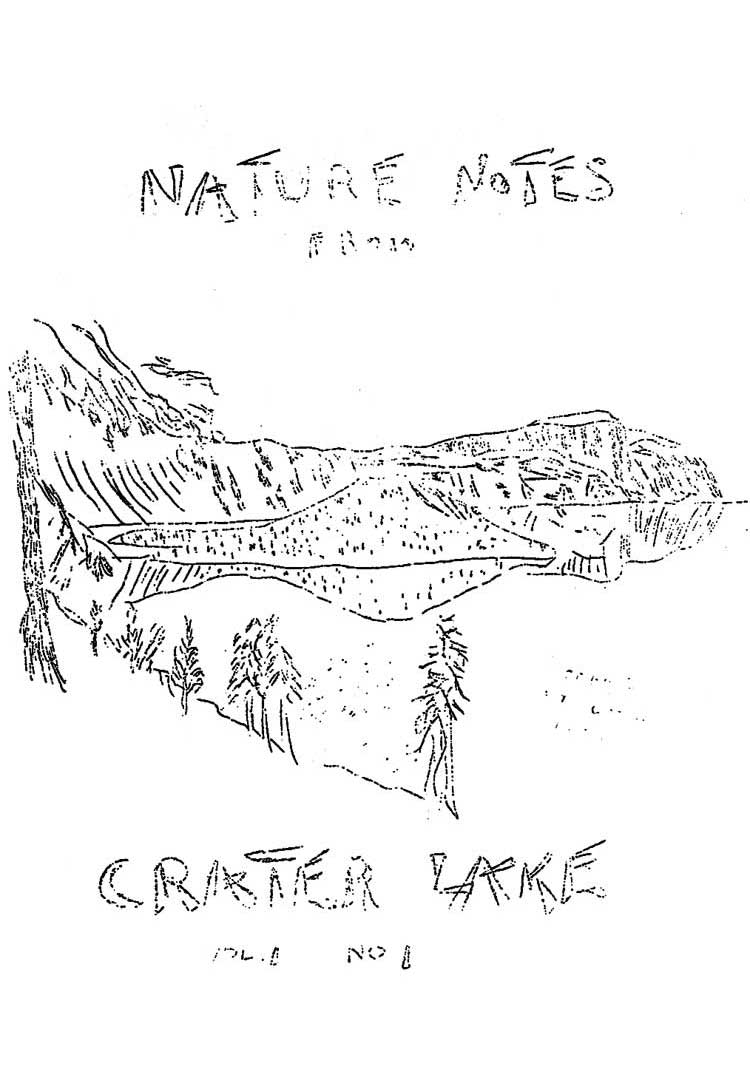
Volume I No. 1 – July 1, 1928All material courtesy of the National Park Service.These publications can also be found at http://npshistory.com/Nature Notes is produced by the National Park Service. © 1928. |
Crater Lake
By Earl U. Homuth
In this, the first issue of the first volume of our “Nature Notes from Crater Lake”, it might be well to describe briefly that marvelous feature which is known as Crater Lake, and to attempt, briefly, to outline the theories as to its origin.
Crater Lake lies in the caldera of a once mighty mountain. The lake is approximately six miles wide and slightly longer; is nearly 2000 feet deep at the deepest sounding; is surrounded by cliffs varying from 500 to over 1800 feet in sheer height.
Many interesting features may be observed on the walls above the lake; ancient valleys on a still more ancient mountain, filled with lava, and then cut in cross-section to show in perfect clearness; broad glacial valleys opening on the very brink of the caldera, indicating again some points in the history of the original peak; cut edges of as many as thirty successive lava flows and other points illustrating the development of Mt. Mazama. Mazama is the name given to the mountain that once stood here. Evidence that a peak did rise a full ten thousand feet above the lake bottom, or a full seven thousand above the Rim, is derived from four sources.
First, glacial evidence is clear, and the source of the glaciers have been higher than the present rim, since there are no cirques, the cut edges of moraines show at the rim, and the valleys are broad and U-shaped at the very top.
Second, dikes stand out boldly on the inside of the walls, indicating an angle toward an original peak. Fully ten of these can be counted.
Third, the slope of the flow of lava is downward, away from the rim on every side, and the walls are largely the broken edges of these flows, not coated over with other lava material.
Fourth, Wizard Island is a true crater rising to approximately eight hundred feet above the water, or considering the depth of the lake, a cone two thousand eight hundred feet from base to summit. Since the action of a crater builds it up, and material was present to build up this cone, then possibly a previous period of volcanic action could have raised Mt. Mazama to a height where it could rival Mt. Shasta, Hood, and others of our great volcanic peaks.
What became of Mt. Mazama will be discussed briefly in a future issue of these notes.
The Pines of Crater Lake
By F. Lyle Wynd
The pines may be distinguished from other conifers by the fact that the leaves, or needles as they are often called, are borne in clusters; and also by the fact that the seeds are borne in cones. This last character may seem self-evident for certainly any tree in the Pine family should have cones. But this popular conception is untrue as evidenced by three members of the Pine family which are found in the Park which do not have cones
The pines are represented by five species in the Park. The most common one is Pinus contorta or Lodgepole Pine. This is a small tree and grows at all altitudes in the Park. This is the scrubby tree that grows so thickly on the level valley plains.
Pinus ponderosa, or the Western wheat Pine, is represented by wonderfully fine specimens on the lower altitudes.
Pinus lambertiana, or the Western Sugar Pine, also grows at the lower altitudes.
The next occurring in respect to elevation is the Western White Pine, or Pinus monticola.
At the highest altitudes the White-barked Pine grows. Botanists know this species as Pinus albicaulis, which means “white-stemmed” and the appearance of the small branches justify this name.
The pines immediately about the Rim are White-Barked Pine.
–
About Flowers
By Earl U. Homuth
The flora of Crater Lake has not been very thoroughly studied, and offers unusual opportunities. This may be due to a comparatively short season, and possibly because other regions are nearer centers of population.
A student from the Univeristy of Oregon, at present collecting in the park, expects to obtain fully five hundred, and possibly seven hundred, species. Seven species were reported as being from Crater Lake only, but a report from the national herbarium invalidates one determination and two others are reported from one station in northern California, while another is found in this region, but outside the park boundaries. The remaining three are Colomium mazama, Cov., Arinaria pumicola, Cov. and Leib, and Eucepahlus covellii, Greene.



